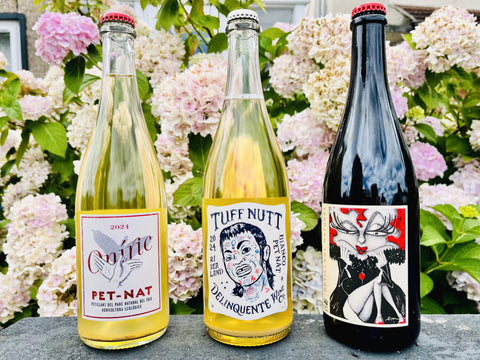Summer is just around the corner so picture this: sunny Greek islands, tables loaded with olives, oil-marinated feta and juicy stuffed vine leaves. Now, add a crisp and refreshing glass of Greek wine to complete the scene. Are you still with us? This isn’t just a dream, it’s a taste of Greece’s great wine renaissance.
With a winemaking history dating back to ancient times, the country's more than 300 indigenous grape varieties are creating wines that deserve your attention. While challenges like drought and wildfires have tested Greek vineyards, their resilience has only strengthened the quality and character of their wines.
From the volcanic soils of Santorini producing mineral-driven Assyrtiko to the bold reds of Nemea made from ancient Agiorgitiko vines, Greek wines aren’t trying to imitate a Bordeaux or a Burgundy, they’re bringing about their own history and terroir.
For natural wine lovers, Greece represents a particularly exciting territory. At the forefront of the challenges caused by climate change, many producers work with minimal intervention, letting their indigenous varieties and unique microclimates take the lead to create beautifully balanced wines.

The region
Greece might be small, but when it comes to wine, the offering can be as varied and exciting as French, Spanish or Italian, thanks to the diversity of landscapes in the country and its mix of mountains, islands, seaside towns and ancient soils.
There are the bold, structured reds like Xinomavro growing near Mount Olympus, bright, mineral whites like Assyrtiko thriving in the volcanic island of Santorini, and fragrant, slightly wild Malagousia coming out of the hills around the mystic region of Delphi.
Greek wines are typically known for their brightness and food-friendly character, often with distinctive mineral qualities and herbal notes that come from the Mediterranean climate and ancient soils. And while climate change is putting pressure on some traditional varieties, it's also pushed producers toward more sustainable farming. Many of them combine traditional techniques like dry-farming with organic and biodynamic methods, making low-intervention wines that respect both winemaking history and the land, and bringing about wines full of character.

Key Greek grape varieties you should know
Assyrtiko (White)
-
Region: Mainly from Santorini, grown on volcanic soils shaped by sea winds and sunshine.
-
Character: Crisp, bone-dry, with naturally high acidity and a strong mineral backbone.
-
Flavour profile: Bright citrus (think lemon peel and grapefruit), salty sea breeze vibes, and a touch of smokiness.
-
Pair it with: Grilled fish, salty cheeses, anything lemony or Mediterranean: perfect with mezze or a big Greek salad.
Moschofilero (White)
-
Region: From the high plains of the Peloponnese, particularly Mantinia.
-
Character: Aromatic and slightly oily in texture, with refreshing acidity.
-
Flavour profile: Floral (rose petal and orange blossom), a bit spicy, with hints of peach and lychee.
-
Pair it with: Fragrant dishes: herby roast chicken, mild curries, or anything with a bit of ginger or citrus zest.
Roditis (White)
-
Region: Grown widely across Greece, often at altitude, especially in the Peloponnese.
-
Character: Light-bodied, an easy-going white with gentle acidity.
-
Flavour profile: Green apple, citrus peel, sometimes with a soft saline note.
-
Pair it with: Great with everyday dishes: white bean salads, light pasta, grilled veggies, or just on its own.
Xinomavro (Red)
-
Region: Northern Greece: particularly in Macedonia, Naoussa and Amyndeon.
-
Character: Firmly structured and tannic, built for ageing, often compared to Nebbiolo.
-
Flavour profile: Sour cherry, sun-dried tomato, black olive, with earthy and spicy notes over time.
-
Pair it with: Hearty foods: lamb, slow-cooked stews, or mushroom-heavy dishes. Decant if it’s young!
Agiorgitiko (Red)
-
Region: Nemea in the northeastern Peloponnese.
-
Character: Softer and rounder than Xinomavro, with plush fruit and mellow tannins.
-
Flavour profile: Juicy red berries, warm spice, sometimes a cocoa or dried herb edge.
-
Pair it with: Tomato-based dishes, grilled meats, or a mezze spread. A crowd-pleaser.
Retsina (White or Orange-ish)
-
Region: Traditionally from Attica, but now made across Greece.
-
Character: Made with pine resin. But today’s natural Retsinas are lighter, more balanced, and surprisingly refreshing.
-
Flavour profile: Herbaceous, citrusy, with a gentle lift of pine or rosemary.
-
Pair it with: Salty, snacky foods like olives, anchovies, or even chips.
Our favourite Greek wines selection
Antiphon Red Blend - Tetramythos Winery (Peloponnese, Greece)
A vibrant, easy-drinking natural red from the costal Peloponnese, made with organic and minimal intervention, this blend of Agiorgitiko, Mavro Kalavrytino and Mavrodaphne captures the character of the region while staying smooth and super drinkable.
Expect juicy red cherry, subtle spice and wild herbs, with grippy tannins and a touch of earthy energy.
Pairs with: Grilled lamb, lentil stews, roasted aubergine, or just a simple charcuterie board.
Alkemi Rosé – Markovitis Winery (Naoussa, Greece)
Crafted by one of Greece’s natural wine pioneers, this is an impressive rosé with structure and soul, made entirely from the native Xinomavro grape in the hills of Naoussa.
Dry and textural, it bridges the gap between a chillable red and a serious pink, offering complexity without losing freshness.
Notes of blood orange, tart raspberry, herbs and a savoury edge make this a standout rosé with plenty of grip.
Pairs with: Grilled halloumi, herby mezze, oily fish or anything Mediterranean with bold, fresh flavours.
‘Skyphos' Assyrtiko – Artisans Vignerons de Naoussa (Naoussa, Greece)
A rare inland take of Assyrtiko, grown in the cooler, higher-elevation vineyards of Naoussa by a sustainable grower collective.
This is a lean, mineral-driven white with a refreshing and herbal edge that reflects the mountainous terroir.
Expect citrus zest, crushed stone, wild herbs and a salty finish, less volcanic power than Santorini, but no less character.
Pairs with: Fresh seafood, spinach pies, mezze or lemony greens.
The Orange Point – Artisans Vignerons de Naoussa (Naoussa, Greece)
A gentle and accessible orange wine, made from local white grapes (Assyrtiko and Roditis) with skin contact, this is a great entry point into the world of skin-contact wines.
Fermented naturally and left unfiltered, it’s structured but approachable, offering depth without heaviness.
Flavours of apricot skin, orange peel, tea-like tannins and a savoury lift make this an incredibly versatile bottle.
Pairs with: Roasted squash, spiced rice dishes, aged cheeses or rich mezze spreads. Serve slightly chilled.
Conclusion
Greek wine is having a quiet revolution, shaped by working on ancient soils, using resilient grapes, and led by a new generation of winemakers rising to meet the pressures of climate change with care and creativity. Whether you’re into mineral whites, textured rosés, or lively, food-loving reds, there’s something truly exciting and still surprisingly undiscovered waiting for you in the Greek wines world.
Explore our full Greek selection here.


